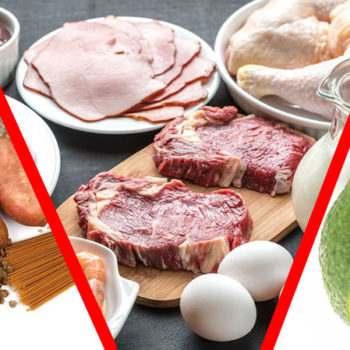Fat Loss Diet: Foods With a High Thermic Effect

Use the thermic effect of food to boost your metabolism and move ever closer to your target body fat levels.
Successful fat loss dieting means taking advantage of every single weapon in your kit bag.
You’ve nailed your calorie intake and your diet is looking healthy. You’ve been hitting the gym much more frequently too.
Now it’s time to speed up your results by choosing foods with a high thermic effect and really ramping up that metabolism.
It’s time to make big changes to your body with small changes to your diet.
You need foods with high thermic effect.
This is what we’ll cover:
- What is the thermic effect?
- What’s the relationship between your metabolism and thermic effect?
- Which foods have a high thermic effect?
Energy Expenditure and Weight Loss
The physiology of fat loss is actually pretty simple. And while the human body is dynamic in nature, the rules of thermodynamics still apply.
When you eat food you get energy. This is measured in calories.
Calories refers to the energy needed to raise one kilogram of water by one Celsius in temperature. This is why we often call food energy kilocalories.
The fact that energy can’t disappear and can’t be destroyed means that when you eat food you either use these calories as fuel, or you store them for later.
Calorie intake and energy input
The macronutrients that provide you with energy are:
- Carbohydrates – 4 kilocalories per gram
- Protein – 4 kilocalories per gram
- Fats – 9 kilocalories per gram
All human actions require energy – whether it’s breathing, thinking or moving. Without calories your body wouldn’t be able to function properly.
The more you weigh, the more energy you need from food to maintain your mass. If you’re an active person, you need to eat much more to function.
Burning calories and energy expenditure
By the law of thermodynamics, energy can’t be created or destroyed – only transferred.
The energy you break down and use as fuel is called energy expenditure.
And the total number of calories you burn each day is referred to as your total daily energy expenditure (TDEE).
You use calories in the following ways:
- Basal metabolic rate – this is the energy you use for simple functions such as maintaining muscle mass, kidney and liver function, maintaining heart rate and regulating brain and nervous system function. It accounts for as much as 60-70% of your TDEE.
- Physical activity – any time you move your body you need energy. Walking, foot tapping, fidgeting, housework, gardening and any other non-exercise activity is responsible for around 20-25% of TDEE.
- Exercise – whether it’s sports, the gym or an aerobic class; structured exercise makes up a surprisingly small 15% of TDEE.
- Thermic effect – when you eat food you need to use energy for digestion and absorption. It might only be 5-10% of your TDEE but it soon adds up.
Note: These estimated percentages are based on a relative scale so don’t necessarily add up to 100%.
Balance your calories to achieve fat loss
The ‘calories in, calories out’ model has been shown in the research to determine what happens to your weight and body fat [1].
Whether you gain weight, lose weight or stay the same weight is dependent on balancing your energy intake against expenditure.
Much like a seesaw.
If you take in more energy than you burn off through TDEE each day, your body chooses to store the excess as fat. It converts the energy and stores it as triglycerides in your adipose cells.
But if you take in less energy than you burn off through exercise, metabolic rate, physical activity and thermic effect of food, you force those fat cells to open up.
Once you grab that extra fuel from your fat cells your body uses it to make up the difference. And over time, your fat stores get lower and lower, until finally you’ve got a solid set of abs and you’re looking toned and athletic.
Summary: Calorie rules
- If you eat more calories than you burn off you’ll gain weight.
- Burn off more calories than you eat and you’ll lose fat.
- Balance calorie intake with TDEE and your weight will remain the same.
What Is the Thermic Effect of Food?
The thermic effect of food is the amount of energy it takes to break down, digest, assimilate, and then absorb food.
Sometimes referred to as Specific Dynamic Action (SDA) and diet-induced thermogenesis, the thermic effect is a large component of metabolic rate, with an increase in heat being shown to elevate thermogenic metabolism after eating.
As we’ve already mentioned, the thermic effect of food accounts for around 5-10% of your total daily energy expenditure.
That’s the equivalent of 250-300 kilocalories for the average trained male athlete.
You need to use energy to digest food
When you eat food your metabolism goes up. It does this so that your body can break down the calories and extract what it needs from it.
The process of digestion is complex and involves both mechanical and chemical processes.
Here’s a quick summary of what happens when you eat:
- While chewing your food, enzymes in your saliva begin breaking down any starches.
- You use your tongue to push food toward your throat. After swallowing, muscles in your esophagus push the food down to your stomach.
- After entering the stomach, digestive juices and acids break down the food and turn it into a creamy liquid called chyme.
- Once in the small intestine, nutrients are absorbed as they pass slowly through the tube like structure of the gut.
- The large intestine absorbs any left over water and breaks down any waste.
- You then eliminate what’s left.
Different foods have different thermic effects
The increase in metabolism from the thermic effect is largely dependent on the types of food you eat.
When it comes to different macronutrients, some require more energy to digest and therefore raise the metabolism higher than others.
Thermic effect of different macronutrients [2]:
- Fats have a thermic effect of only 0-3%
- Carbohydrates have a thermic effect of 5-10%
- Protein has a thermic effect of 20-30%
Protein is the nutrient that increases your metabolism the most – as much as 10 times that of fats.
In other words, protein-rich foods provide the best metabolic boost for your fat loss diet.
And if you were to have a mixed meal (which to be honest is more than likely the case in the real world), adding protein to it would increase the combined thermic effect.
It’s always worth adding just a small amount of protein to each meal to keep the thermic effect elevated.
But there are also some other potent fat burning foods that help to raise metabolism too…
Foods With a High Thermic Effect
While calorie balance is your number one priority when on a fat loss diet, the following foods will help to keep your metabolism ticking over at a higher rate.
Combine these with a solid exercise plan and a calorie-controlled diet and you’ll be looking leaner in no time.
- Green tea – elevates fat oxidation, metabolic rate and also decreases appetite too
- Chicken and turkey
- Fish
- Cayenne pepper – has a direct effect on fat loss and metabolic rate in clinical trials
- Eggs
- Complex vegetables, brown rice, oatmeal and beans
- Caffeine has been shown to boost metabolic rate, sports performance and even cognitive abilities
Summary – Foods With a High Thermic Effect
The thermic effect is the measure of how much energy you burn in order to digest food. It has an effect on your metabolism and when you eat, your energy expenditure increases.
There are a number of thermogenic foods that raise body temperature and boost your ability to burn fat when in a deficit.
Combining these foods with a calorie-controlled diet and regular exercise is the key to getting leaner, stronger and shaping your best body yet.



